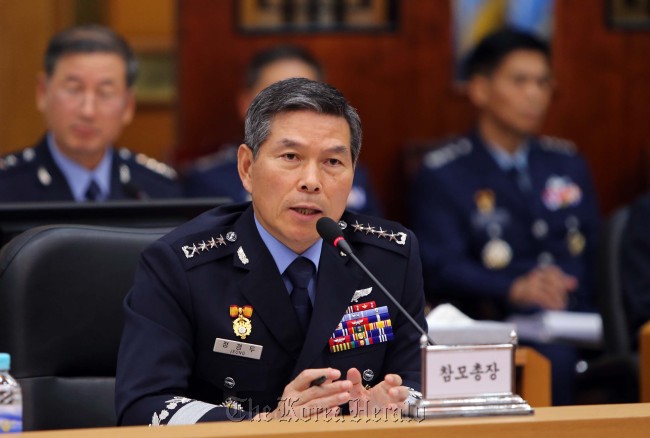Stationing an advanced U.S. missile defense unit on the peninsula will cost around 3 trillion won ($2.6 billion), the new Air Force chief of staff said Tuesday, though he reasserted that South Korea and the U.S. are not currently in talks over its purchase.
“It should be about, give or take, 3 trillion won,” Gen. Jeong Kyeong-doo said in response to Rep. Kim Kwang-jin of the main opposition New Politics Alliance for Democracy during a parliamentary audit at the Air Force’s headquarters in the Gyeryongdae military compound in South Chungcheong Province, referring to the Terminal High Altitude Area Defense. THAAD is designed to shoot down short-, medium- and intermediate-range ballistic missiles in the final stage of their flight.
But he did not provide details on the estimate, saying the figure is an approximate one and was also mentioned in news reports.
“It should be about, give or take, 3 trillion won,” Gen. Jeong Kyeong-doo said in response to Rep. Kim Kwang-jin of the main opposition New Politics Alliance for Democracy during a parliamentary audit at the Air Force’s headquarters in the Gyeryongdae military compound in South Chungcheong Province, referring to the Terminal High Altitude Area Defense. THAAD is designed to shoot down short-, medium- and intermediate-range ballistic missiles in the final stage of their flight.
But he did not provide details on the estimate, saying the figure is an approximate one and was also mentioned in news reports.

Jeong’s remarks represented a rare assessment by a South Korean military executive because the government has shied away from giving numbers, saying it will not have to shoulder any costs even if Washington eventually decides to bring in the asset, as it will do so on its own. A THAAD battery, which consists of six truck-mounted launchers, 48 interceptors, an air-transportable radar system and a fire and communications element, had widely been valued at 1 trillion won to 2 trillion won, and no more than two units would likely be put in place here.
For its part, Seoul is seeking to develop the L-SAM, a long-range surface-to-air missile with similar interception capabilities as part of its initiative to establish an independent missile defense system, called the Korea Air and Missile Defense.
Jeong also remained cautious about THAAD, saying the Air Force is pursuing the KAMD program and adopting the U.S. system may entail other problems such as bringing in necessary intelligence surveillance reconnaissance assets to operate alongside it.
“There are various conditions in order to operate THAAD,” he said. “The Defense Ministry will carefully review its stationing taking into account various security factors. ... On the military aspect, a THAAD deployment has pros and cons. It has merits and limits.”
The former vice Air Force chief of staff and Joint Chiefs of Staff head of strategic planning took office last week.
Controversy has repeatedly brewed over the issue in recent months after top Washington officials including Secretary of State John Kerry and U.S. Forces Korea commander Gen. Curtis Scaparrotti raised the need for future discussions between the allies on a THAAD deployment.
The U.S. has activated four THAAD batteries in the mainland and Guam and plans to complete the deployment of the other three by as early as 2019 including on overseas locations that may include South Korea, Japan and the United Arab Emirates.
During the session, the issue also precipitated spats between senior ruling and opposition lawmakers.
Rep. Yoo Seong-min of the Saenuri Party lambasted as “deceiving” Jeong’s plan to defend from North Korean missile attacks with the KAMD system and homegrown mid- and long-range ground-to-air missiles.
In contrast, New Politics Alliance for Democracy chairman Rep. Moon Jae-in opposed a THAAD stationing, saying it is not cost-effective and Seoul will ultimately have to share a greater burden in other ways.
By Shin Hyon-hee (heeshin@heraldcorp.com)


![[Exclusive] Korean military set to ban iPhones over 'security' concerns](http://res.heraldm.com/phpwas/restmb_idxmake.php?idx=644&simg=/content/image/2024/04/23/20240423050599_0.jpg&u=20240423183955)

![[Graphic News] 77% of young Koreans still financially dependent](http://res.heraldm.com/phpwas/restmb_idxmake.php?idx=644&simg=/content/image/2024/04/22/20240422050762_0.gif&u=)



![[Pressure points] Leggings in public: Fashion statement or social faux pas?](http://res.heraldm.com/phpwas/restmb_idxmake.php?idx=644&simg=/content/image/2024/04/23/20240423050669_0.jpg&u=)









